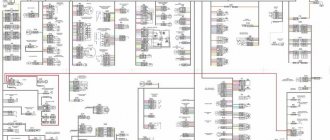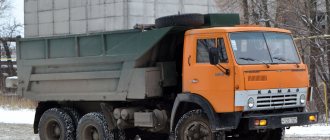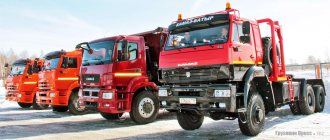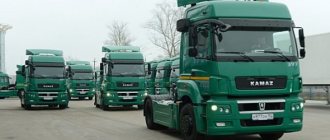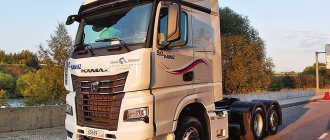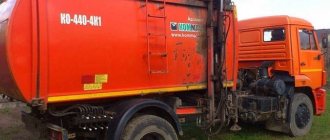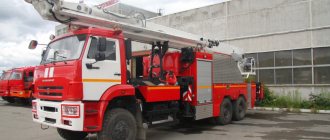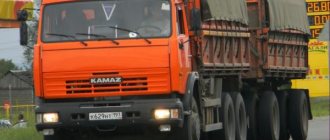KamAZ 43118 is an all-wheel drive truck characterized by increased cross-country ability.
In the basic version, the model is produced with an on-board platform, but it is possible to install specialized equipment to solve specific problems. This special equipment is a multi-purpose all-terrain vehicle that allows you to overcome even serious off-road conditions. KamAZ 43118 is in demand in a variety of sectors of the economy and industry due to its relatively moderate price, significant off-road characteristics and good load capacity. again, the model is used in rescue services and in the army. Recently, the Kama Automobile Plant began production of an updated version of the car with improved parameters, which had a positive effect on its popularity.
General information
KamAZ 43118 is one of the most famous models of the Kama Automobile Plant. Its story began in the late 1980s. It was then that the company began to think about creating an advanced truck with increased cross-country ability. At that time, many government agencies (rescue services, the Ministry of Defense, fire services) needed a car that would simultaneously have the following properties: it did not require regular repairs, did not require specialized maintenance, and felt comfortable on any off-road terrain. At that time, no truck met these parameters.
In 1992, the Ministry of Defense issued an order to the Kama Automobile Plant for the development and production of such cars. The basis for creating the model was the all-wheel drive KamAZ 4310, the first mention of which appeared in 1967. It is noteworthy that the latter was developed by the designers of the ZIL plant. Subsequently, the documentation for it was transferred to the Kama Automobile Plant, where it was put into production. In 1989, this truck underwent a global modernization. It was the updated version that served as the basis for the KamAZ 43118 model.
The truck turned out to be quite successful, and in 1995 the Kama Automobile Plant began its production. The first versions looked little different from other products of the brand and were very popular. The car received a branded cabover operator's cabin with a brand inscription on the radiator grille, a large windshield divided in half by a partition, and a minimum level of comfort in the cabin. The image was complemented by a massive metal bumper with headlights integrated into it. The design of the equipment turned out to be both discreet and brutal and fully corresponded to the motto “Tanks are not afraid of dirt.”
In 2010, KamAZ 43118 underwent a restyling procedure that changed its configuration and appearance. The frame of the operator's cabin was preserved, but the execution turned out to be more modern. Many elements have been modified and replaced with new ones. The model received a streamlined molded bumper, painted in the color of the operator's cab, modified rear-view mirrors, integrated side fairings and a completely redesigned radiator grille. The updates also affected the optics: headlights, direction indicators and dimensions were combined into a single unit. The windshield was made one-piece, which significantly improved visibility for the driver. again, the quality of finishing materials has improved. One of the main innovations was the appearance of a berth, despite the fact that KamAZ 43118 was considered exclusively as a carrier for short and medium distances. The sleeping area was small, but it allowed for rest. A soft mattress was also included in the basic package. Structurally, there were significantly fewer changes. The developers reviewed individual components, making the truck more durable and reliable.
Currently, several modifications of the KamAZ 43118 are produced. The basic version of the vehicle is actively used in various fields of energy and construction. The truck has significant cross-country ability and is excellent for transporting timber in hard-to-reach areas and transporting a variety of cargo and people from oil and gas companies. Endurance makes the KamAZ 43118 very popular and allows it to maintain a stable demand for it. Again, specialized modifications of equipment are produced (tanks, log carriers, drilling rigs, truck cranes, tractors) designed for specific tasks. At the same time, the model, regardless of the type of execution, operates confidently and reliably in all weather and road conditions, which distinguishes it from its competitors.
Specifications
KamAZ 43118 has a 6 by 6 wheel arrangement and the following dimensions:
- length – 8580 mm;
- width – 2500 mm;
- height – 3455 mm;
- wheelbase 3690 mm;
- ground clearance - 385 mm.
Platform dimensions (for onboard versions):
- length – 6100 mm;
- width – 2320 mm;
- side height – 500 mm.
Interestingly, the impressive size of the car did not prevent it from being quite maneuverable. To turn the car, 12300 mm was enough.
Model weight characteristics:
- curb weight – 10300 kg;
- front axle load – 4780 kg;
- load on the rear bogie – 5520 kg;
- total weight – 21600 kg;
- front axle load – 5800 kg;
- load on the rear bogie – 15800 kg;
- weight as part of a road train - 33600 kg;
- load capacity – 11225 kg.
With a fairly large mass, KamAZ 43118 stood out for its reasonable level of fuel consumption - about 33 l/100 km. The model was equipped with 2 types of fuel tanks: 350 l and 210 l. The maximum speed was 90 km/h, the climb angle was 60 degrees.
KamAZ-43118
A. Erokhin, photo by the author
It is probably difficult today to find a person who does not know the cars produced by KAMAZ OJSC. This is not surprising, since the enterprise is the largest in the world among factories producing trucks. Today, however, product output is far from production capabilities, but the plant is working to improve the quality of its models. The testing department of our editorial team managed to obtain for testing a rather interesting car from the wide range of the car plant’s model range - KamAZ-43118 with a 6x6 wheel arrangement.
The machine is equipped with a turbocharged engine and intercooled charge air. The engine develops power of 245 hp. at 2,000 rpm and maximum torque of 1,060 Nm at 1,200–1,400 rpm. The car has a flatbed body, starting immediately behind the cabin, of the maximum possible length. Accordingly, the spare wheel is not located in its usual place, but at the rear under the frame. The KamAZ-43118 body can be with or without an awning. You understand that not everyone needs an awning, and the opportunity not to pay for an unnecessary accessory when buying a car pleases the consumer.
It is very pleasant to note that the carrying capacity of a three-axle all-wheel drive vehicle is 11 tons. And our car is equipped with a tire pressure regulation system, and it is equal in the tires of all axles. Thanks to this, the inconveniences that we encountered when experiencing some all-wheel drive two-axle vehicles disappear (see “Two-axle vehicle from Miass”).
What's new in this KamAZ? In short, firstly, tires size 425/85R21 with a speed index J, corresponding to a permissible speed of 100 km/h. And in terms of load capacity, they are quite sufficient for this machine. And secondly, it is equipped with a ZF 9S 109-494 gearbox, 8-speed, with a top gear ratio of 0.74. Why we drew your attention to this will become clear later. Thirdly, the cabin of our car is equipped with a hydraulic lift. In this case, it is a necessity: it is simply impossible to raise the cabin at such a height manually. Probably everything is new.
We set out on a route simulating city traffic. Having measured the fuel consumption of an empty car, we can say that the car demonstrates very decent efficiency and dynamics. In fact, 32.5 l/100 km at an average speed of 38.6 km/h for a four-wheel drive car is really good.
Having driven this route several times, both independently and with a factory test driver, we are convinced that the gear shift drive is not entirely successful. This can be judged by the fact that while driving along the 18-kilometer IGD route, each of them made from three to five mistakes when switching. In our opinion, the problem is that the selection stroke is too small, while the inclusion strokes are chosen well.
For an empty car with, naturally, the highest gear in the transfer case, the most convenient gear shift algorithm is as follows: 2 – 4 – 6 – 7. At speeds on the IG route of no more than 60 km/h, there is no point in going higher than 7th gear.
On the dynamometer test, after warming up the car, we determine the maximum speed and, with some surprise, note: 125 km/h. Well, this is already very good for an all-wheel drive car. The fuel consumption values also pleasantly surprised us. Agree that 18.4 l/100 km at 50 km/h or 27.8 l/100 km at 80 km/h are very good figures, especially for an all-wheel drive vehicle. We also measured fuel consumption on a dirt road. It is clear that the ground is not asphalt, but driving on it with such a cab suspension is not much pleasure. The test dirt section is full of ups and downs; for a dirt road it is quite flat, and at the time of testing the empty car was dry. You can completely forget about any comfort when moving on the ground, so we chose the speed of movement based on the opportunity to somehow sit in the cabin while working with the equipment. There are no complaints about the car, with the exception of strong shaking on almost unnoticeable, at first glance, uneven roads.
Having finished working with an empty car, we load it with ballast and repeat all the runs. On the IG route, having measured fuel consumption, we note that a vehicle weighing more than 21 tons is quite dynamic. Eight main stages of the ZF gearbox and an additional reduction gear are quite enough for this car. In the highest gear in the transfer case, the most convenient gear shift algorithm turned out to be: 1 – 3 – 5 – 6 – 7. True, fuel consumption has increased quite significantly compared to an empty car. Apparently, this is due to a noticeable increase in the rolling resistance of well-loaded tires. The average speed dropped by only 1.3 km/h. Fuel consumption at steady-state speeds on the dyno road also increased significantly for the same reasons.
Technical characteristics of KamAZ-43118 (6x6)
| Length, mm | 8 635 |
| Width, mm | 2 500 |
| Height, mm | 3 840 |
| Curb weight, kg | 10 400 |
| Front axle load, kg | 4 700 |
| Load on rear bogie, kg | 5 700 |
| Load capacity, kg | 11 000 |
| Total weight, kg | 21 400 |
| Front axle load, kg | 5 600 |
| Load on rear bogie, kg | 15 800 |
| Engine | 740.30-260 |
| Type | Diesel with turbocharging and intercooler |
| Rated power, gross, kW (hp) at min–1 | 180 (245) at 2,000 |
| Maximum torque, Nm at min–1 | 1,060 at 1,200–1,400 |
| Working volume, l | 10,85 |
| Piston stroke x cylinder diameter, mm | 120x120 |
| Final drive ratio | 6,53 |
| Transmission | ZF-9S109-494 |
| Type | Mechanical, 8-speed, with additional reduction gear |
| Top gear ratio | 0,74 |
| Tires 425/85R21 or KAMA-1260 | |
| Maximum speed, not less, km/h | 90 |
Top speed dropped to 102.8 km/h. With a load, the engine power with the existing transmission ratios is no longer enough. However, this value is quite enough for such a machine.
After taking measurements, I would like to say a few not entirely pleasant words to the manufacturers. As we have already said, the car is equipped with a centralized tire inflation system. The tire pressure gauge has an upper limit of 6 kg/cm2, and the recommended tire pressure is 5.6 kg/cm2. Of course, the pressure is set when the tires are cold. When moving, they heat up and the pressure increases significantly. But it was not possible to establish exactly to what value, since the pressure gauge needle rested against the limiter.
Atmospheric conditions
| Temperature, °C | +5…+7 |
| Wind speed, m/s | 1–3 |
| Pressure, hPa | 992-997 |
| Relative humidity, % | 77–80 |
The tests were carried out on the dynamometer road of the test site in accordance with the methodology set out in GOST 20306-90 and GOST 20576-90.
From experience we can say that on Ural-43206, for example, when the pressure in cold front axle tires is 3.5 kg/cm2, when driving at maximum speed, it increases by almost 2 kg/cm2. Therefore, it is simply impossible to install a pressure gauge with such a measurement limit on the KamAZ-43118.
Test results KamAZ-43118
| Test weight, kg | 9 700 | 21 430 |
Fuel consumption, l/100 km at speed, km/h:
| 18,4 21,0 24,3 27,8 31,3 44,4 32,5 (38,6) 44,4 (32,8) | 31,4 33,0 37,2 41,8 46,6 53,0 53,1 (37,3) 76,7 (28,1)* |
| Maximum speed, km/h | 125,0 | 102,8 |
| Acceleration time on the way 400 m from a standstill, s | 29,2 | 36,0 |
| Acceleration time to 60 km/h from standstill, s | 17,0 | 37,1 |
| Coasting from 50 km/h, m | 555 | 765 |
*– tests with full load were carried out on a dirt road after rains.
There are two problems here: good imported tires and slightly better fuel efficiency of the engine. But in terms of price we have a significant advantage over imports. Apparently, this is where we stand on the market, because if you evaluate equipment based on price-quality ratio, then many Russian consumers will choose KamAZ.
In conclusion, let’s say that in today’s market the KamAZ-43118, as an all-wheel drive vehicle with a payload capacity of 11 tons, already has its niche.
Engine
In the basic modification, KamAZ 43118 was equipped with a KamAZ 740.50-300 diesel V-shaped unit with turbocharging. The power plant complied with the Euro-4 environmental class. Engine characteristics: displacement – 11.76 l, rated power – 221 (300) kW (hp), maximum torque – 1177 Nm, number of cylinders – 8, compression ratio – 17.
Some modifications were equipped with a KamAZ 740.30-260 turbocharged diesel engine. Unit characteristics: working volume - 10.85 l, rated power - 191 (260) kW (hp), maximum torque - 1060 Nm, number of cylinders - 8, compression ratio - 16.5. The engine complied with the Euro-4 environmental class.
All versions of the model were equipped with a specialized electric torch device, making it easier to start the engine in winter. A pre-heater with manual pumping was functionally offered.
KamAZ 4311 - a selection of materials, prices, links, photos and videos about the car
The cost of the new KamAZ-43118 in the basic configuration is 1.8-2 million rubles. Modifications with installed special equipment will cost more – 3-4 million rubles.
Used cars are slightly cheaper - 1.1-1.2 million for the 2007-2008 version. Renting KamAZ-43118 trucks is also in demand. For an hour of work here you will have to pay 1200-1500 rubles.
Analogs
An analogue of the KamAZ-43118 model is its “classmate” - the KamAZ-65117 tractor.
| Description: Kamaz 4311 | Description: Car for sale: KAMAZ 4311 2011 | Description: Kamaz 4311 |
| Description: Selling flatbed KamAZ 4311 | Description: KAMAZ 4311 armored | Description: Kamaz 4311 |
43114, 1991, 100,000, 400,000, 10850, Flatbed truck. Samara, Yes. 4311, 1982, 50,000, 550,000, 210, Timber carrier. Murom, Yes. 43114, 2005, 119,656 ...
The truck's power unit is a 740.30-260 turbodiesel with an air intercooling system with a capacity of 245 horsepower. Unlike many KAMAZ models, on 43118 the cargo platform is installed close to the cabin, which made it possible to make it as long as possible.
The spare wheel, which is usually located behind the cab on KamAZ vehicles, in this case received its place at the rear under the frame. The cargo platform is produced in two different versions - the buyer can choose its tented or tentless version.
Updated KAMAZ 43118
It should be noted that the all-wheel drive three-axle truck with a 6x6 wheel arrangement has a load capacity of 11 tons. The vehicle being tested is equipped with an automatic tire pressure regulation system. On this model, the tire pressure on all axles is equal, which eliminates the inconvenience that annoyed us when testing all-wheel drive two-axle trucks.
Overall dimensions of KAMAZ 43118
A few words about what new we saw in the car. First of all, these are tires of size 425/85R21, with J indexing, which has a speed tolerance of 100 km/h. This tolerance is fully consistent with the vehicle’s carrying capacity. Another new product was an eight-speed ZF licensed gearbox with a highest gear ratio of 0.74. And the last innovation is a hydraulic cabin lift, without which tilting the high cabin would be very problematic.
Photo
Device
The KamAZ 43118 is based on a durable chassis that allows for the installation of a wide range of attachments. In comparison with the more common versions KamAZ 43114 and KamAZ 43101, the model has a greater load capacity due to the reinforced suspension and frame. Many elements used in this car are domestic.
The truck is equipped with an all-wheel drive chassis. The differentials of all axles are symmetrical. Thanks to them, the car overcomes even severe off-road conditions. KamAZ 43118 uses spring suspension. Unique pneumatic tires with automatic pressure regulation were specially created for this model. They can withstand increased load. Tire characteristics – 425/85 R21.
The KamAZ 43118 brake system includes several elements. The main braking system is pneumatic. The wheels are equipped with drums with a diameter of 400 mm. The parking brake is activated by moving the handle to the desired position. The car has a spare brake system, provided as insurance in case of breakdown of the main one. It is controlled similarly to the parking brake. Due to this, the driver can slow down on slippery roads by moving the handle approximately a third of the way up. With further ascent, the remaining brakes of the road train are activated. The auxiliary braking system is activated by a dedicated button. It allows you to effectively overcome long descents as part of a road train. The auxiliary system is designed to operate without changing gears (in one gear in effect at the time of its operation). This mechanism reduces the risk of brake overheating.
KamAZ 43118 is equipped with 2 types of transmissions: a 10-speed gearbox of our own production or a 9-speed ZF gearbox. Both gearboxes are manual. The main gear includes a shaft with bearings and a crankcase. In this case, the main gear gears work until they are completely worn out, so the main gear is not disassembled during operation. Transfer case 2-speed manual with lockable center differential and pneumatic control. The ZF transmission in the car design is considered the most reliable element and significantly improves the dynamic parameters. Compared to the domestic gearbox, it has a longer service life. However, during long-term operation, its drive makes errors in switching stages.
The KamAZ 43118 operator’s cabin does not have a significant level of comfort. Until 2010, special equipment was equipped with the old type of operator’s cabin, developed back in the 1980s. The new modifications have an operator's cabin with a medium-sized berth, which is convenient for long-term transportation. The interior is equipped with a soft chair with mechanical adjustment and air suspension. Only the driver receives such amenities; everything in the passenger seat is much more modest. Modern cladding materials and a revised duct system improve noise and heat insulation. Heated seats, air conditioning, armrest, standard CD radio and electric windows are functionally available. again, the car can be equipped with an anti-theft system, which can be unlocked with a specialized key.
Disadvantages of KamAZ 43118:
- the tire pressure measurement system operates with serious errors;
- quite high fuel consumption;
- low level of comfort in the cabin.
Despite the existing shortcomings, the model is in stable demand due to its acceptable quality-to-price ratio. Most foreign competitors do not surpass KamAZ 43118 in terms of technical characteristics, but are more expensive. This is what forces domestic consumers to choose the product of the Kama Automobile Plant.
DUMP TRUCK AS 10-8 GPA UST 5453 KAMAZ 43118-50
Convenience, comfort and practicality
The AS 10-8 GPA UST-54535V dump truck consists of a van
and
a dump platform.
The van body is all-metal, frame construction. The outer lining of the van is made of steel sheet, the inner lining of the van is made of plastic, and polystyrene foam is used as thermal insulation of the van. The van's floor is four-layered and consists of plywood, a layer of polystyrene foam, plywood and a rubber-plastic covering. Mounting on the chassis is carried out using brackets and stepladders located symmetrically relative to the longitudinal axis.
Natural lighting, ventilation and the necessary visibility in the passenger compartment are provided by a window with a window. It is made using a double sealed double-glazed unit made of safety glass with a 60 mm thick seal. At night, the van body's cabin lighting is electric from the lampshades.
The interior is heated by an air heater and a heater from the engine cooling system. Autonomous air heaters use their own power source and are independent of the standard heating system.
The van's interior is equipped with a table top, two 3-seater passenger seats, three-point seat belts, and fire extinguishing equipment.
The use of high-quality materials and components in the manufacture, finishing and configuration of the van’s interior allows us to ensure a high level of organization of the repair work performed . Calculated design , high quality and wear resistance of materials used in the finishing of the van body ensure reliability and long service life of the van.
Folding passenger ladder
The lowered entrance in combination with a folding two-stage staircase provides the maximum combination of ease of boarding for passengers and compactness in the transport position. The steps of the stairs are made of corrugated stainless steel sheet. To facilitate passenger entry and exit, the staircase is equipped with a handrail. To illuminate the entrance area when boarding and disembarking passengers, a lighting lamp .
Organization of on-board electrical network
The van's electrical system is designed to use an on-board power source . The 24V DC voltage is supplied from the base vehicle's electrical circuitry. To illuminate the passenger compartment in conditions of poor visibility, the van is equipped with lampshades. A “cabin-lounge” intercom is installed in the van body.
Tipper platform
Platform with rear unloading through a folding tailgate with automatic locking. The mechanism for raising and lowering the platform is hydraulic, with direct action of the hydraulic cylinder on the platform, with the placement of the hydraulic cylinder under the platform in the area of the balancing trolley. Provides lifting and lowering of the platform, stopping it in any position. The mechanism for raising and lowering the platform is electro-pneumatic remotely controlled from the driver’s cabin.
